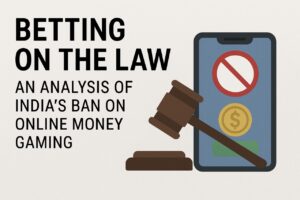In a small city, a man started a textile company named Sanvi Collections and from the beginning they maintained honesty and transparency in their work and products. Their commitment to quality did not just made overnight, there is a consistent hard work behind it. When a batch of fabric once arrived with minor defects, the company didn’t hide it; instead, it offered customers a choice of refund or replacement, even at a loss. The act of resolving the issues of customers with respect and transparency resulted in winning hearts of the customers at large. Soon, customers began recommending the brand not just for its products, but for the trust it inspired.
Over time, the goodwill earned became the company’s strongest asset—an invisible yet powerful currency. Banks extended loans on favourable terms, employees took pride in working there, and customers stayed loyal even when competitors offered cheaper prices. Sanvi Creations’ story proved that goodwill, once built, could outshine even the most glamorous advertisements.
In today’s market, where competition is only increasing day by day and products are often similar in quality, what truly sets the product unique is not just the low price but the goodwill of the company. The goodwill of the company is essential not just for the customer’s trust but to build the relation and good networking in the market. It is an incorporeal asset that reflects trust, loyalty, and credibility over time. It is vital for long term success in the market.
GOODWILL IN BUSINESS
Goodwill is not just about hosting a get together with clients, it’s an intangible asset. It represents the value that the company and its products built by having loyal customer base, strong brand, a good team of employees etc. In the business world, when one company acquires another, it’s goodwill they’re really paying for to be a successful brand in future. When a business is well-regarded, its name generates positive reactions, fostering trust and a sense of community. You can’t buy or sell goodwill directly. Beyond its material possessions and physical location, it captures how the general public views the company’s worth. The premium that consumers are prepared to pay simply to be associated with your brand is what it is. On a global scale, goodwill is also valued under intellectual property (IP) frameworks. For instance, under trademark law, a brand’s “reputation” in the marketplace is frequently associated with goodwill. By restricting others from fake advertising their products or services as belonging to a recognised brand, the passing-off principle primarily protects goodwill.
COMPONENTS OF GOODWILL
a. Brand Recognition
Brand name could not be just purchased; it creates on the market value as a result of consistent efforts and hard work by providing good products and services to the customers with the updated version of it over the time. Giving customer service and marketing plays a major role in creating a market value.
b. Customer Loyalty
The satisfaction and trust of the customer on the brand and product is the main source of goodwill of the brand in the market. It grows over the time with the consistent efforts of the company. The value of customer loyalty and relations is especially evident in how resilient it makes a business against competition and market fluctuations.
c. Employee Expertise
The brand value is equally proportion the employees and their skills of tackling the issue the company face on day to day basis, whether it’s a customer complaint or market fluctuation. The way an employee handle the situation, the bigger the brand value becomes over the time.
CHALLENGES
A company can trademark and copyright its brand and products but it cannot codify its brand value. Instead, it is protected by consistent quality, legal protections, and strict enforcement. Litigation is complicated because proving goodwill in passing-off suits frequently requires substantial proof of reputation, market presence, and customer perception. Some key challenges are –
a. Evidentiary Burden
Due to its intangible nature, goodwill is generally difficult to measure or demonstrate in a court of law. The claimant must prove reputation, consumer association, and actual or likely harm in circumstances involving passing off or unfair competition. Extensive documentation such as sales data, advertising spending, customer surveys, or independent reports is required to meet this evidentiary burden, and it can be expensive and time-consuming.
b. Volatility of Reputation
Goodwill is directly linked to consumer perception, which can change abruptly as a result of business errors, social media backlash, or market trends. Years of reputation-building can be undone by a single faulty product, controversy, or unfavourable review. Legally speaking, this vulnerability makes appraisal more difficult during mergers and acquisitions, and disagreements frequently occur when the anticipated goodwill differs from the actual goodwill following the deal.
c. Overlap with Intellectual Property Rights
Trademarks, trade dress, and brand reputation are often linked with goodwill. Goodwill, however, cannot be legally documented or granted an independent licence, in contrast to a registered brand. It is indirectly protected by related intellectual property rights. This overlap complicates enforcement methods by introducing ambiguity into conflicts, such as whether the injury is to the trademark or to the brand’s overall goodwill.
d. Digital Era Vulnerabilities
Both risks and benefits of goodwill are increased by the internet and social media. Goodwill can be quickly harmed by concerted smear operations, deepfakes, online impersonation, and fake websites. Businesses are frequently forced to play catch-up as legal remedies like takedown notices, cyber-squatting legislation, or defamation cases fall behind the pace of digital harm.
CONCLUSION
Goodwill is essential to maintain a brand’s competitive edge and market identity; it is not just a by-product of successful business. Legally speaking, it acts as a barrier against unfair competition, a gauge of transaction value, and a checkpoint for customer confidence. Companies who make an effort to foster goodwill not only strengthen their resilience but also gain legal recognition for their priceless but invisible asset.
Essentially, a brand’s transformation from survival to success is the conversion of trust into goodwill.
-By Vaishnavi Verma



